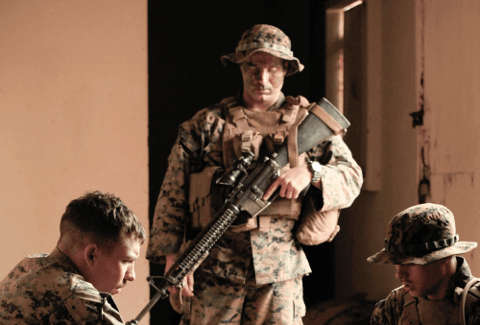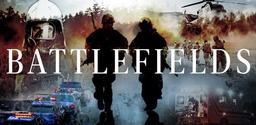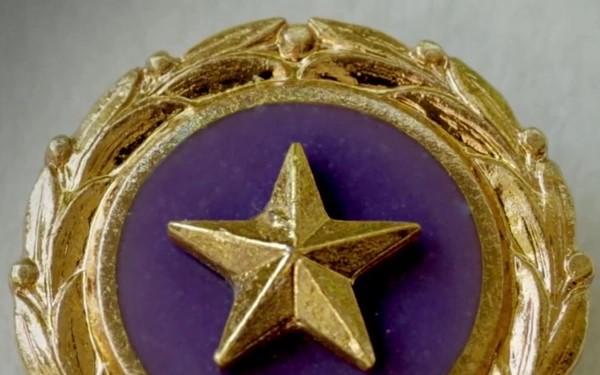Total darkness. The other side of midnight. For the first time in his 20 years of service with NYPD, Sergeant Don Young was paralyzed and didn’t know what to do. On a clear cloudless day in lower Manhattan, he had suddenly been plunged into a total black hole of smoke. At approximately 10:28 a.m. on Sept. 11, 2001, Don was just one block away from 200 Greenwich Street on his way to conduct rescue operations there. As he approached the World Trade Center, the building at 1 World Trade Center—the North Tower—began its collapse, sending out a cloud of toxic smoke that instantly turned the entire atmosphere into noxious poison.
Standing behind a concrete wall on the West Side Highway, Don attempted to take a breath and realized that if he inhaled, he would be asphyxiated. Just at that moment of wondering if he would make it out alive, an NYPD Emergency Services Unit (ESU) officer wearing a Scott air pack approached out of nowhere. The ESU officer tapped Don on the shoulder, took off his mask, and gave Don the breath of life. The two men buddy-breathed with the fresh air until the smoke cleared, and then the ESU officer disappeared into the distance. It was so dark that Don never saw the ESU officer or identified him by nametag. Don never saw his rescuer again, and never found out who he was. The events of the next few days were so tumultuous that Don was unable to recall what happened to him for 17 years after that fateful day. Saved by an angel in the darkness, Don’s life direction changed over the next few years. One of those changes led to a revolution in the conduct of urban warfare.
Anyone familiar with New York City in the 1980s knows what a wild place it was at the time. In the four Brooklyn housing projects that Don was assigned to patrol, there were more than 500 murders in just one year—almost a quarter of the annual total murders in the city. The crack epidemic was reaching its peak, and the drug dealers were shooting at each other every day; the MAC-10 was the weapon of choice. Many innocent bystanders were hit during the gunfights. It was in this hostile environment that Don honed his street smarts, and developed the tools to be a top-level crime fighter. But as tough as he was, Don always did his work with compassion, once doing CPR on an infant stricken with SIDS he knew was long gone just to help the family cope with the loss he knew was inevitable. “The incident still haunts me to this day,” he said.
Don’s adeptness in the streets was a major asset to the NYPD, where he became a member of the elite Street Crime Unit, a front-line force in the department to take out drug dealers, gang members, and other high-visibility crime in the city. Operating at night when the most street crime takes place, the motto of the SCU is “We own the night.” Don had a distinguished career in SCU, earning the rank of sergeant during the last few years of his service. Simultaneously during Don’s last few years with NYPD, he began to work in foreign conflict zones on assignment with the United Nations. “If you could pick the top 10 worst countries to be in, I’ve probably worked in seven of them,” said Don. His first foreign service assignment was in Bosnia, where from 1997 to 1998, he worked as a UN monitor with Serbian police on the zone of separation between Bosnia and Srpska, known officially as the Inter-Entity Boundary Line.
Don worked in the city of Brčko, where Arkan’s Tigers had conducted their genocidal operations and saw firsthand the results of the civil war that tore apart the region. Following that assignment Don worked in East Timor, living for two months during the summer of 1999 in a village with two UN volunteers before Indonesian-backed militias forced them out. As the situation deteriorated, Don ended up in a warehouse guarding 1,400 East Timorese refugees with Australian police officers. If the refugees had been abandoned, they would have been killed by the militiamen. The UN envoy wanted to leave the country. But Don and his 11 fellow officers remained with the refugees until Australia accepted them and they were flown out of the country. With the refugees safely evacuated, Don was the last man out of East Timor. “I just looked at it as the right thing to do,” he said in a September 2020 interview. His actions in that crisis are mentioned in Tammy Pemper’s book “Scorched Earth.” Don Young’s most dangerous assignment was to the Democratic Republic of the Congo, where the hazards of tropical diseases are more severe than combat.

Don retired in 2002 from NYPD after a 20-year career with the department. His street smarts, work in the SCU, and foreign assignments prepared him for the next phase of his life. In 2006 the situation in Iraq had deteriorated, forcing the military to think about the war in a different way. In response to the insurgency, two programs were created, the Joint IED Defeat Organization (JIEDDO), and the Law Enforcement Professional Program (LEP). A group of 100 civilian law enforcement officers was initially hired to work with deployed infantry units in the Army and Marine Corps. The Defense Department (DoD) sought police officers with urban experience in drugs, gangs, and organized crime. Don fit the profile perfectly and was accepted as an LEP contractor in the fall of 2007. He attended the orientation course in Virginia, and in early December 2007 he was attached to the 3/2 Stryker Cavalry Regiment, the “Wolfpack,” commanded by LTC Rod Coffey. He caught up with the unit as it was headed to Diyala Province, where it conducted operations for the remainder of its deployment.
Don had been with the unit for a week when he got his first chance to go on a mission with the men. The 3/2 SCR officers weren’t sure how to use him, and the noncommissioned officers didn’t quite trust Don, thinking he was there as a part of the CID. During a tabletop meeting at FOB Warhorse, LTC Coffey said, “Who wants Donnie?”
First Sergeant Bill Goudy said, “I'll take him!”
“They were ripping during that time,” said Don. “They were going to terrorist camps and facilities at a high tempo of clear and move.” Don’s first day in the field was one of the most fateful days of the insurgency.
On Jan. 9, 2008, a squad from the 3/2 SCR entered a building in Sinsil, Iraq, looking for insurgents. It had been cleared two weeks before, but unknown to the men, insurgents had reentered the building and wired an IED inside it. The whole building exploded, causing it to collapse, killing six service members, an Iraqi interpreter, and wounding several other men. Don heard the call on the radio, and said to the men he was with, “Get me over to the IED blast!” but they continued with their mission in another area. Don realized the difference in mindset: “When a cop gets shot, everybody rallies to the scene. But not the military.”
Don in Afghanistan: About to Blow Up Enemy Cache
In the days after the bombing, individual members of the unit returned to the scene to dig it out and recover the personal effects of the lost and wounded men. Don realized that if he could go to the building wreckage, he could find evidence of who planted the IED and maybe get an ID on him. So Don went to LTC Coffey and the unit XO to state his case. In an emotional meeting, Don said he could get the personal effects of the lost men and find evidence of who the bomber was.
The XO said there wouldn’t be enough resources. LTC Coffey listened impassionately, and after both men said their piece, he said to Don, “How much time do you need, Donnie?”
Don replied, “Three days.”
LTC Coffey responded, “Okay, I'll give you a day!”
It was, at the time, completely out-of-the-box thinking by LTC Coffey, as devoting precious resources to site exploitation was unheard of. Working with two other civilian police officers, Don game-planned what they were going to do at the building site, and the unit members collected backhoes and sawzalls to get through the tons of concrete and rebar.
On a day in early February 2008, members of the 3/2 SCR cordoned off the area around the blown-up building in Sinsil; the backhoes came in and 30 unit members and two law enforcement officers under Don’s direction began a systematic search through the building rubble where seven men were killed. They found personal effects of the lost men, including wallets, radios, maps, and some human remains, which were given dignified service. And Don’s men discovered the trigger device that set off the IED. The trigger was taped up, and on the tape, Don found a clear fingerprint of the bomber. The print was sent to the burgeoning DoD insurgent database for examination.
Flush with the successful mission to the building wreckage, Don’s reputation was solidly established with the officers and men of the 3/2 SCR. Don realized that he needed to become an instructor to the entire Stryker Regiment. “If I don’t teach anybody, I’m just one guy.” So every time he went with the men on a mission, he taught them crime-fighting techniques at the raid site. “Everything is a teaching moment,” said Don. “Guys sign up to be soldiers, not cops. But this is not like other wars. We needed to shake the low-hanging fruit to get the higher-ups; dismantle gangs [just like working in New York City].” So Don taught the men of the 3/2 evidence-gathering techniques. The medics were the first ones to learn what to do. They didn’t have professional collection kits, so they used plastic baggies and paper bags for the blood evidence to prevent it from spoiling. When the mission tempo slowed down, Don began to teach the men, in three-day classes, evidence gathering.

The payoff was huge. Regular infantry soldiers were able to go into a raid house and find IED parts and other important evidence of terrorist networks. One place yielded a drawer full of refrigerator motors used for building IEDs; another place had five burner phones used as trigger devices. Laptops, sim cards, pocket trash with numbers on them—all evidence of a terror network’s “who’s who.” Don instructed the infantrymen on how to do a proper search of a room. Evidence from one raid enabled the unit to roll up a terrorist at another location without firing a shot. Don was teaching “Police 101,” but it was essential to the success of the mission of the 3/2 SCR while it conducted operations in Diyala during its 15-month deployment.
Most indispensable were Don’s 20 years of work busting criminals, which paid off in his ability to offer human intelligence. “I’m a street guy,” said Don. “The interrogators got trained at Huachuca but I got trained on the street, so I know when people are lying … And when you see strange behavior from people on the street, you know something’s up.” And Don is circumspect about his deployment with the 3/2. “We made mistakes. One day, guys were standing looking at a car rigged to blow. The sergeant blew a gasket and came up to me, and told me we could have lost everybody. He told the lieutenant that we have to be on point. He was right.”
Years after his deployment with the 3/2 SCR, Don was deployed with the Asymmetric Warfare Group to Afghanistan and ran into one of the law enforcement officers he had served with in Iraq. He told Don that the Sinsil 7 bomber had been caught, tried in an Iraqi court, and executed for his crime. Don realized that the identification of the Sinsil bomber was proof of concept for the LEP program, and provided a revolutionary model for how urban warfare could be conducted.
His background as an urban police officer provided invaluable assistance to infantry soldiers to take down terrorist networks, find IED builders, and identify bad actors with malevolent intentions. There is much evidence to indicate that civilian law enforcement has a significant role in the conduct of modern war. In addition to direct assistance in the conduct of missions, they can be used to help train partner forces. One retired Special Forces operator told me that the civilian police officers who contracted with his group to Afghanistan did such a good job of training the Afghan National Police (ANP) that the insurgents specifically targeted the ANP personnel.
Most importantly, Don is proud of the fact that his work to identify the Sinsil 7 bomber provided some closure to the families of the six service members who lost their lives that day. And when the 3/2 SCR alumni gathered at Arlington in March 2019 for the funeral of its former commander, LTC Rod Coffey, the men made sure that Sergeant Don Young, NYPD-Retired, was a part of the group photograph at the reception following the service. He was, and is, truly one of them.




